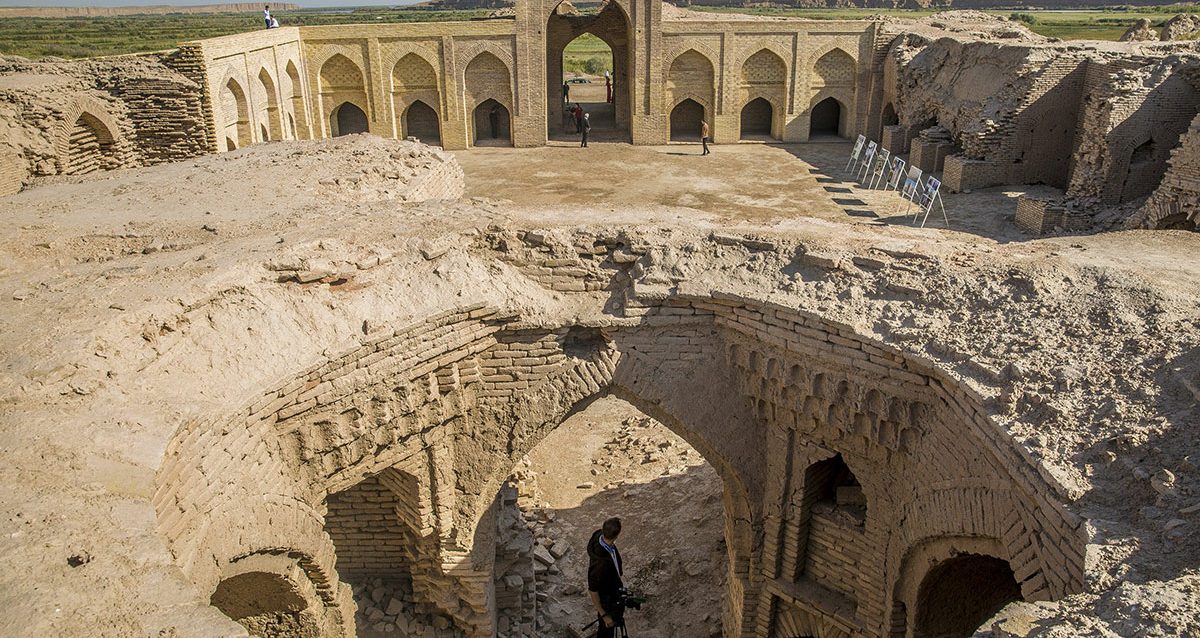The Dayahatin Architectural Monument is one of the best-preserved caravanserais that has stood since the heyday of trade between East and West.
The caravanserai, located in northern Lebap province, about 170 kilometers (170 km) from Turkmenistan, was built about a thousand years ago on the northern part of the Great Silk Road. Its wall decoration, arched braids, doves, and domes are all of baked brick.
Over the years, the effects of rainfall have had a negative impact on the sturdy hedgehogs. To prevent further disintegration of the caravanserai, the National Directorate for the Protection, Study and Restoration of Historical and Cultural Monuments under the Ministry of Culture of Turkmenistan, with the support of the U.S. Ambassador’s Treasury for the Preservation of Cultural Heritage, has carried out the first phase of renovation work. Weak walls, gutters, and crevices have been conserved. The front of the courtyard on the northeast side of the gallery has been partially rehabilitated, and the narrowed upper part of the main entrance has been restored. Bricks from the Middle Ages were used and new bricks were made. The initial stage of the project was carried out by architects Derkar Dovletov, Ruslan Myradov, Maksatmyrat Amanov, Rakhmanguly Yazhanov and Khalykberdi Annaguluyev under the leadership of Candidate of Historical Sciences Muhammad Mammedov.
Before the caravanserai, a rectangular fortress (Arabic-rabat) was built here at the beginning of the 9th century. These military fortifications are designed to protect the borders of the Muslim world in the remote regions of Central Asia. At that time, Tahir ibn Hussein was the emir of the Arab Caliphate in Khorasan. The first name of the fortress is associated with the name of this figure, who left a significant mark on the history of early Islam.
During the Seljuk era, in the 11th-12th centuries, it was transformed into a caravanserai built on the road from Amul (modern Turkmenistan) to Khorezm. Medieval craftsmen used baked brick as an ornamental material to decorate the walls, and traces of minarets have survived here. Galina Pugachenkova, a well-known historian who participated in the research at the monument, said: “The expansion of the boundaries of international economic relations between East and West led to the construction of more and more caravanserais and markets. These spacious buildings are striking in their elegance and architecturally perfect. The caravanserai of the Uncle admires with its richness of brick decoration inside and out,” he said. As you get closer to the caravanserai, you notice the opulent entrance of the Dayhat and other buildings that are surrounded by fragments of clay walls that have not survived to this day. The 112×125 area of the ancient caravanserai is also impressive.
At the entrance to the rectangular courtyard, three symmetrically decorated panels form a lofty arch. They bear the inscription ‘Allahu Akbar’ in brick and the names of the Prophet Muhammad (peace be upon him) and the names of the four companions: Abu Bakr, Omar, Uthman and Ali.
The entrance to the caravanserai was located on the north side near the Amygdala. By doing so, the craftsmen would protect it from the hot sandy breeze and provide a pleasant air for the farmers. Rooms of different sizes with domes were at the control of the guests. There are also ornate guest houses, which testify to the fact that Daihati was not only a place for the rest of the merchants, but also a place where the dignitaries of the noble emirs who retired to their respective estates.
The absence of doors and the presence of thin gaps in the adjoining rooms indicate that the caravanserai was used for this purpose only in the summer. There are air purifiers around the perimeter of the building. The owners of the ancient ‘hotel’ also maintained warehouses and utility houses, and places for animals and their food were located in a spacious two-bay area around the caravanserai. Created on the basis of aerial photographs, the design of this medieval monument is a testament to the meticulous design and perfection of every piece of this medieval monument.
“The architecture of the Dayakhat caravanserai is the epitome of perfection, in which the purpose, artistic perfection and functional value of the structure are inseparably concentrated,” Galina Pugachenko emphasizes. Turkmen restaurateurs have refurbished the medieval “hotel” into a new form, and after the completion of the initial phase of renovations, the next stage of work will be determined to preserve the Dyakhatyn caravanserai, which has been inscribed on the UNESCO World Heritage List.

